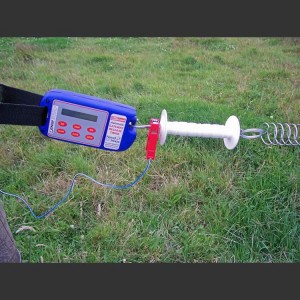Juan P. Alvez | Pasture Technical Coordinator, Center for Sustainable Agriculture – UVM Extension
Being a farmer is simply one of the busiest human activities so, what grazing farmer wouldn’t benefit from an automatic gate opener?
We recently learned about this useful device with the ability to automatically open gates. It is called a ‘Batt-Latch.’ A Batt-Latch is an electronic locking device (developed by NZ company Jenquip), that incorporates a timer that can release the gate latch at a specified time to open a gate into another paddock. It’s a solar-powered all-weather device that releases an attached spring-gate or tape-gate at a preset time, and is especially suited to the release of grazing animals in pastured and feedlot situations.
With the addition of an optional pipe gate adapter, the Batt-Latch can be used to open almost any type of farm gate. Besides grazing stock applications, it can be used for release of free-range chickens and almost any application that can be initiated by a mechanical switch or release.
Once trained, animals quickly learn to move themselves onto the next paddock. A series of Batt-Latch units can be set up increasing animal moves daily, enhancing grazing efficiency and saving farmers’ precious time.
How does it work?
Once you know how many animals will graze a given area and you have calculated how much dry matter per day is available for their needs, preset paddocks can be established in sequence. Batt-Latch devices are placed to secure the gate of each paddock. Once the timer completes its cycle the latch opens, releasing the gate, allowing animals to walk into the new paddock. Animals will learn quickly and will move themselves as many times a day as the Batt-Latches are set, increasing forage efficiency and animal gain..
This way, farmers can have time to do other chores without worrying that animals won’t have enough to graze. This video, by David Nortunen at Hidden Vue Farm in northern WI, shows how the process works.
With a Batt-Latch device, livestock producers have the convenience of relying on an electronic device to automatically move cows to the next pasture. It can be set up the same morning or the day before.
What doesn’t it do?
There is no electronic device that can monitor pasture’s growth and development and make management decisions for the grazing farmer. For that reason, farmers still need to walk their pastures in order to keep the best sense of their animals’ and forage availability. A Batt-Latch will be very good at doing what is programmed to do: opening the gate at the pre-set time.
Have you explored different successful forage management ideas? You can share them dropping us a line at the UVM Pasture Program:
Juan Alvez (jalvez@uvm.edu); Kimberly Hagen (kimberly.hagen@uvm.edu) and, Jennifer Colby (jcolby@uvm.edu)



[…] Skipping pastures where forage is ready to graze may entail more labor by moving animals to the right place, a few times a day. However, it is a no-cost opportunity to enhance both soil and animal health as your livestock is able to harvest more forage in its optimum stage, while also extending the grazing season. (Plus the answer to a need for a bit more labor can even be easily solved remotely, pre-setting a few Batt-Latch automatic gate openers.) […]